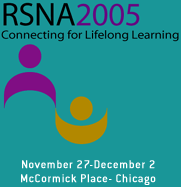
Abstract Archives of the RSNA, 2005
Craig I Horenstein MD, Presenter: Nothing to Disclose
Micheal D. Phillips MD, Abstract Co-Author: Nothing to Disclose
Kenneth Baker PhD, Abstract Co-Author: Nothing to Disclose
Mark J Lowe, Abstract Co-Author: Nothing to Disclose
Brian Kopell, Abstract Co-Author: Nothing to Disclose
D Malone, Abstract Co-Author: Nothing to Disclose
Benjamin Greenberg, Abstract Co-Author: Nothing to Disclose
Benjamin Greenberg, Abstract Co-Author: Nothing to Disclose
Ali R. Rezai MD, Abstract Co-Author: Nothing to Disclose
et al, Abstract Co-Author: Nothing to Disclose
To study the pattern of fMRI activation produced by DBS electrode stimulation for depression
DBS electrodes were placed in the anterior limb of the internal capsule with the distal contact in the nucleus accumbens in a patient with intractable depression. The patient was imaged on a 3T Siemens Allegra MRI (Erlangen, Germany) on postoperative day 1. Externalized leads were connected to a pulse generator in the MRI control room. Scanning consisted of a 3D anatomic data set with the leads disconnected from the pulse generator, and BOLD fMRI with a single lead connected to the pulse generator. Bold images were acquired separately for each DBS lead, stimulating with lead contacts 0 and 2 using parameters determined during surgery. Assessment of symptomatic efficacy for stimulation was performed at the time of surgery. BOLD fMRI was performed with a block paradigm consisting of 5 stimulator off and 4 stimulator on 32 second epochs. 10 seconds were placed between the stimulator off and on conditions, in order to gradually ramp the stimulator to the optimal stimulation level. Images acquired during the ramping process were discarded. The MRI time series at each pixel was fit using least squares to a boxcar reference function plus a slope and intercept.
Stimulation with contact 0 from either lead improved the patient's symptoms and corresponding activation was seen in the ipsilateral putamen and dorsal medial thalamus, and contralateral cerebellum. Stimulation with contact 2 on the right exacerbated the patient's depression, while contact 2 on the left produced equivocal changes. Stimulation with these contacts resulted in activation of the ipsilateral medial thalamus and the contralateral cerebellum. No putaminal activation was seen. In both cases, additional activation occurred in the ipsilateral frontal lobe (Brodmann areas 8/9).
In a patient receiving DBS therapy for depression, stimulation of the nucleus accumbens with lead contact 0 produced symptomatic relief of the patient's symptoms, while stimulation of the anterior limb of the internal capsule with contact 2, produced a markedly different pattern of fMRI activation and exacerbated the patient's condition.
Horenstein, C,
Phillips, M,
Baker, K,
Lowe, M,
Kopell, B,
Malone, D,
Greenberg, B,
Greenberg, B,
Rezai, A,
et al, ,
Functional MRI (fMRI) Evaluation of Deep Brain Stimulation (DBS) for Treatment of Depression. Radiological Society of North America 2005 Scientific Assembly and Annual Meeting, November 27 - December 2, 2005 ,Chicago IL.
http://archive.rsna.org/2005/4418009.html

